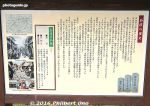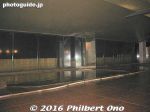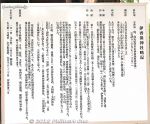Ikaho Onsen Hot Spring Spa
|
Title   • File Name • File Name   • Date • Date   • Position • Position   |
|

Ikaho Onsen is a well-known hot spring resort in Shibukawa, Gunma Prefecture. It is on hilly terrain, near mountains, making it cooler than Tokyo in summer.
|
|

Ikaho was a favored summer retreat for the Imperial family and political figures in the late 19th century. Ukiyoe print of Ikaho.
|
|

From Tokyo's Buster Shinjuku bus terminal at Shinjuku Station, it takes about 2 hr. 40 min. to Ikaho, costing about ¥2400.
|
|

From Tokyo, going by bus is more convenient than by train. By train from Tokyo, you need to take the shinkansen to Takasaki, transfer trains to Shibukawa, then take a bus to Ikaho.This is the Ikaho Stone Steps bus stop.
|
|

The Ikaho Stone Steps bus stop is at the bottom of the Stone Steps. The Ikaho Onsen bus stop is near other inns.
|
|

At the bottom of the Stone Steps is a waiting room and luggage lockers.
|
|

Ikaho is famous for these Stone Steps (Ishidan) which is the town's main drag. This is at the foot of the steps.
|
|

Ikaho's Stone Steps (Ishidan) go through the middle of the main part of Ikaho. Go up 365 steps to the top with a few breaks along the way. About 300 meters lined with shops and inns.
|
|

Hot spring cascade at the bottom of the Stone Steps.
|
|

Ikaho's spring water runs right below these Stone Steps and you can see it at a few places such as this cascade.
|
|

Hot spring cascade at the bottom of the Stone Steps. The flowing water is hot.
|
|
|
|
|

Ikaho Onsen Stone Steps
|
|

History of the Ikaho Stone Steps. The Stone Steps were first built in 1576 by daimyo Takeda Katsuyori after he lost to Nobunaga and Ieyasu at the Battle of Nagashino.He ordered the Sanada Clan to build the Stone Steps and have Ikaho's hot spring water flow down to feed 12 inns where Takeda's wounded soldiers could heal their wounds.
|
|

Looking at the bottom of the Ikaho Stone Steps.
|
|

Slightly up the Stone Steps is this outdoor stage where they hold hula performances in summer.
|
|
|
|

Irwin Garden
|
|

Lookout point at the garden.
|
|

View from Irwin Garden
|
|

Monument for Toyo Matsugane (1878–1964), a poet. 松根 東洋城
|
|

About Toyo Matsugane.
|
|
|
|

Ikaho Checkpoint (Ikaho Onsekisho) is right above the Irwin summer home.
|
|

Ikaho Checkpoint gate and Irwin summer home in the background.
|
|

Ikaho Checkpoint gate.
|
|

Ikaho Checkpoint. In the old days, travelers could not travel around freely, they had to show travel permits at these checkpoints along the road.
|
|

Ikaho Checkpoint was at the bottom of the Stone Steps. The bottom of the Stone Steps has since been extended more downward.
|
|

94th step of 300+ steps.
|
|
|

You can see the hot spring water gushing down under the Stone Steps. Not really a shrine.
|
|

Rubber duckies won at the shooting arcade game.
|
|

On the right is where you can see the hot spring water gushing down under the Stone Steps.
|
|

Along the way is this hot spring public bath called Ishidan-no-Yu. For people who are not staying in any of the inns, they can still dip into Ikaho's hot spring waters for cheap.
|
|

View from the Ishidan-no-Yu public bath.
|
|

Lounge inside Ishidan-no-Yu public bath.
|
|

Ishidan-no-Yu public bath sign. Open 9:00-21:00 (April to October), 9:00-20:30 (November to March), Closed on the second and fourth Tuesday of the month.
|
|

Tanabata
|
|

Tanabata wishes around July 7 along the Stone Steps.
|
|
|

Engraved on the steps here is a poem titled “Ikaho no Machi” (Town of Ikaho) by Akiko Yosano (1878-1942).
|
|

Free foot bath courtesy of a local inn.
|
|

Ikaho foot bath courtesy of a local inn.
|
|

Hot spring bath in a large hotel in Ikaho.
|
|

In Aug. 2004, along with other major onsen hot springs, Ikaho got caught in a major onsen scandal which started in Shirahone Onsen in Nagano. Onsen managers mixed in tap water and/or bath salts into the water and billed it as natural hot spring waters.Some of Ikaho's major hot spring inns were also found to be adding bath salts or tap water to the hot spring water. Today, all onsen inns must display a certificate indicating the content of their water.
|
|

Gunma-chan horse mascot
|
|

Ikaho souvenir shop
|
|

Kirie cut-out picture of Ikaho Stone Steps.
|
|

Map of Ikaho in the old days.
|
|

Oriental zodiac creatures along the steps. Each of the 12 zodiac creatures indicate the location of the original 12 inns built in the 16th century to heal Takeda Katsuyori's soldiers.
|
|
|
|

Approaching Ikaho Shrine at the top of the Stone Steps.
|
|
|

Ikaho Shrine
|
|

Ikaho Jinja Shrine's main building
|
|

Ikaho Shrine is dedicated to the god of the hot spring and medical treatment.
|
|

Seems to contain a mikoshi portable shrine.
|
|
|

Ikaho Shrine's ema tablets to write your wishes.
|
|

Ikaho Shrine
|
|

Ikaho Shrine
|
|

Lots of stone lanterns at Ikaho Shrine.
|
|
|
|
|

Poetry monuments
|
|
|
|
|
|

Secondary shrines
|
|
|

About Ikaho Shrine
|
|
|

Behind Ikaho Shrine, you can walk further to an outdoor bath near the spring water's origin.
|
|

View of Ikaho from Machi-no-Eki, an exhibition room and ropeway station. Ikaho's first Hawaiian Festival was held here.
|
|
|
|

Inside Machi-no-Eki are displays of art work by local students.
|
|
|
|

Ropeway to Mt. Uenoyama, a mountain on whose slopes Ikaho sits.
|
|

Map of Mt. Uenoyama.
|
|

Lookout deck on Mt. Uenoyama.
|
|

View of Ikaho from Mt. Uenoyama.
|
|

View of Ikaho from Mt. Uenoyama.
|
|

Mt. Uenoyama also has recreational facilities.
|
|
|

Bus stop at Ikaho Stone Steps.
|
|

Bus stop at Ikaho Stone Steps to go back to Shinjuku, Tokyo.
|
|

Waiting room near the bus stop.
|
|

Inside waiting room
|
|

Ikaho mascot
|
|
|
|